 |
 |
 |
| |
Change in lipid markers throughout early adulthood is associated with prevalent NAFLD in mid-life: the coronary artery risk development in young adults (CARDIA) study
|
| |
| |
Lipid Changes in Early Adulthood Predict MAFLD in Middle Age
AASLD The Liver Meeting Digital Experience, November 13-16, 2020
Mark Mascolini
Worsening lipid levels in young adults-especially climbing triglycerides-predicted prevalent metabolic dysfunction-associated fatty liver disease (MAFLD), according to analysis of lipid changes in the US CARDIA Study population [1]. Researchers from Chicago's Northwestern University and collaborators at other centers suggested that tracking rising triglycerides throughout adulthood "is critical for risk-based decision making to determine who may merit targeted and intensive prevention strategies for MAFLD."
MAFLD (sometimes called NAFLD for nonalcoholic fatty liver disease) affects one quarter of the US population and is highly prevalent on other continents as well. Everyone knows that abnormal lipids heighten risk of cardiovascular disease. But the researchers noted that little is known about how lipids change throughout young adulthood and whether these patterns affect risk of prevalent MAFLD in middle age.
To address these questions, the Northwestern team analyzed longitudinal data on lipid changes in young adults in the CARDIA Study [2]. CARDIA includes more than 5000 black and white men and women between 18 to 30 years of age when they entered the cohort in 1985 and 1986 (called young adulthood in this study). CARDIA plans 8 follow-up exams over 25 years in this ongoing study. At year 25 (2010-2011), these people would have been 43 to 55 years old (called middle age in this study).
From the 5115 CARDIA cohort members, the researchers excluded those with insufficient liver fat data and people with cirrhosis, chronic hepatitis, or secondary hepatic steatosis (fat comprising at least 5% of liver weight). That left 2644 CARDIA members eligible for the MAFLD analysis. The investigators measured or calculated total cholesterol, "good" HDL cholesterol, non-HDL cholesterol, "bad" LDL cholesterol, and triglycerides at each study visit and calculated the slope (change) from baseline to the last study visit. They used noncontrast abdominal multidetector CT to assess liver fat at study year 25 (2010-2011) and calculated liver attenuation of the right liver lobe. They defined MAFLD as liver attenuation less than 51 Hounsfield units (HU) after excluding secondary causes of steatosis.
The Northwestern researchers divided their study group into four numerically equal parts (quartiles) for each lipid measured and called quartile 1 stable, quartile 2 minor increase, quartile 3 moderate increase, and quartile 4 major increase. Two logistic regression models assessed potential associations between lipid quartiles and year 25 (2010-2011) MAFLD: Model 1 adjusted for baseline demographics (age, sex, race, study center) and cumulative metabolic factors.* Model 2 adjusted for all the variables in model 1 plus baseline total cholesterol, or LDL cholesterol, or HDL cholesterol, or triglycerides, or non-HDL cholesterol plus levels of other lipids per year.
For triglycerides the 4-quartile breakdown yielded 676 people in quartile 1, 668 in quartile 2, 662 in quartile 3, and 638 in quartile 4. Initial age averaged 24.7 years in quartile 1, 25.3 in quartile 2, 25.0 in quartile 3, and 21.5 in quartile 4 (P = 0.03). Respective proportions of women were 74.4%, 65.1%, 57.7%, and 38.9% (P < 0.001), and proportions with obesity were 7.7%, 10.9%, 13.1%, and 12.5% (P = 0.007). Hypertension prevalence was higher in each higher quartile, but diabetes prevalence and years of education did not differ significantly by quartile.
MAFLD prevalence at year 25 rose steadily from quartile 1 through quartile 4 (from below 10% to about 45%), while average liver attenuation dropped from 60.2 HU in quartile 1, to 58.0 HU in quartile 2, to 55.1 HU in quartile 3, and to 49.4 HU in quartile 4 (with the MALFD cutoff at below 51 HU).
Odds of prevalent MALFD rose with each higher quartile for each lipid level and in both logistic regression model 1 and model 2. For example, compared with people in quartile 1 (stable triglycerides), in model 2 those in quartile 2 (minor increase in triglycerides) had about three quarters higher odds of MALFD (adjusted odds ratio [aOR] 1.78, 95% confidence interval [CI] 1.22 to 2.60), those in quartile 3 (moderate increase in triglycerides) had almost 3-fold higher odds of MALFD (aOR 2.84, 95% CI 1.96 to 4.12), and those in quartile 4 (major increase in triglycerides) had more than 6-fold higher odds of MALFD (aOR 6.41, 95% CI 4.28 to 9.62).
With "good" HDL cholesterol, each higher quartile (representing a higher HDL reading) predicted lower odds of MALFD. In model 2, compared with quartile 1 (stable HDL), people in quartile 2 (minor increase in HDL) had about 45% lower odds of MALFD, those in quartile 3 (moderate increase in HDL) had about 55% lower odds, and those in quartile 4 (major increase in HDL) had almost 80% lower odds of MALFD (aOR 022, 95% CI 0.14 to 0.34). LDL-C and total cholesterol increases over time were also had the highest odds of prevalent MAFLD at year 25, although triglycerides increases were the greatest risk.
The researchers concluded that, among all the lipids they tracked, rising triglycerides in early adulthood (18 to 30 years) yielded the greatest odds of MALFD in midlife (43 to 55 years), regardless of clinical factors assessed and other lipids assessed. They proposed that triglyceride changes over time "may provide additional information for MALFD risk prediction beyond single measures."
*Metabolic measures were cumulative smoking exposure, cumulative alcohol use, cumulative physical activity, cumulative body mass index, cumulative years with diabetes, cumulative systolic blood pressure, and number of years taking blood pressure or lipid-lowering drugs.
Referencesbr clear="all" />
1. Khanna S, Wilkins JT, Ning H, et al. Change in lipid markers throughout early adulthood is associated with prevalent NAFLD in mid-life: the coronary artery risk development in young adults (CARDIA) study. AASLD The Liver Meeting Digital Experience, November 13-16, 2020. Abstract 88.
2. National Heart Lung and Blood Institute. Coronary Artery Risk Development in Young Adults Study (CARDIA).
https://www.nhlbi.nih.gov/science/coronary-artery-risk-development-young-adults-study-cardia
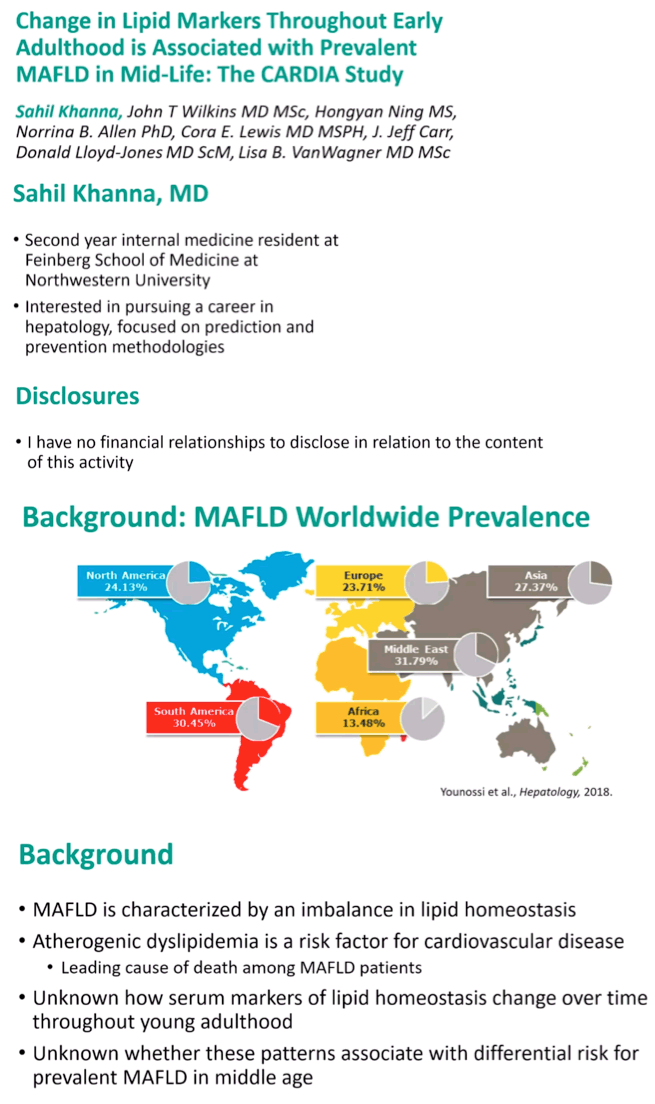
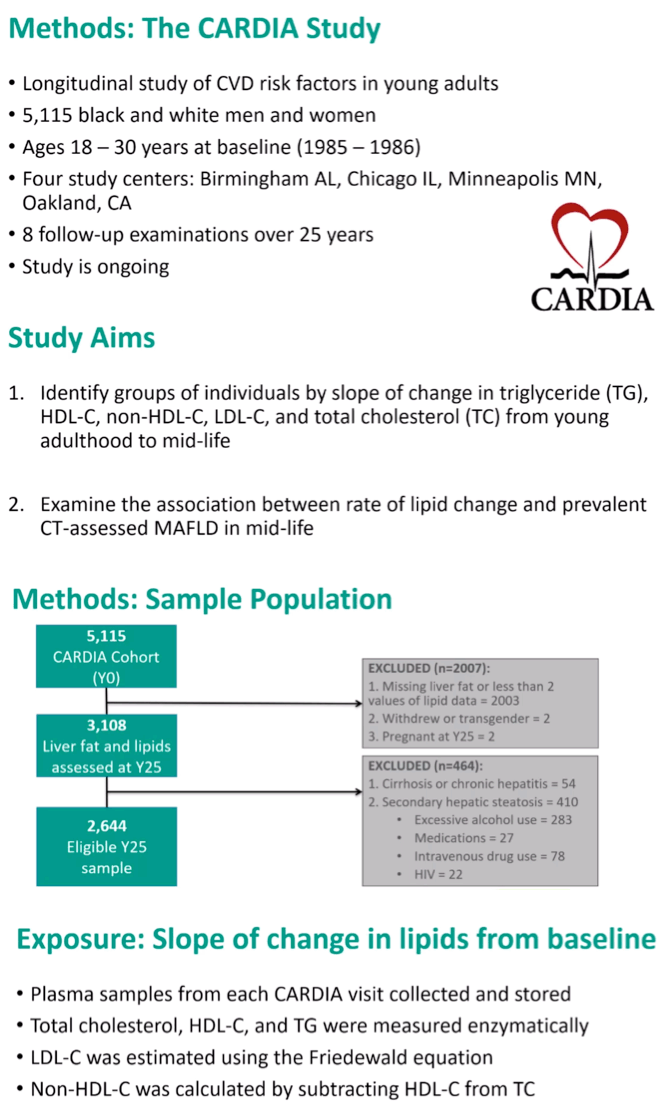
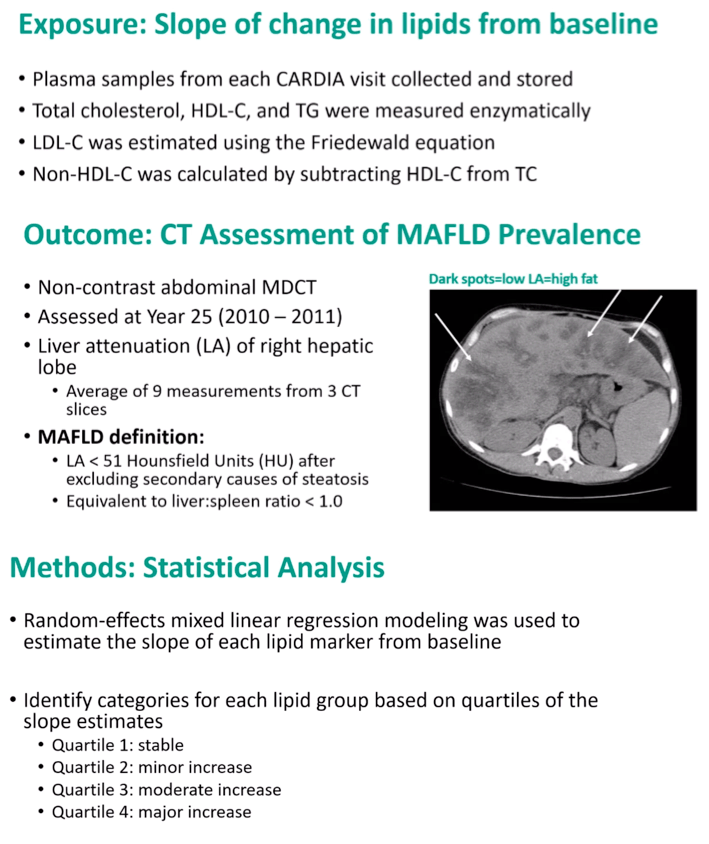
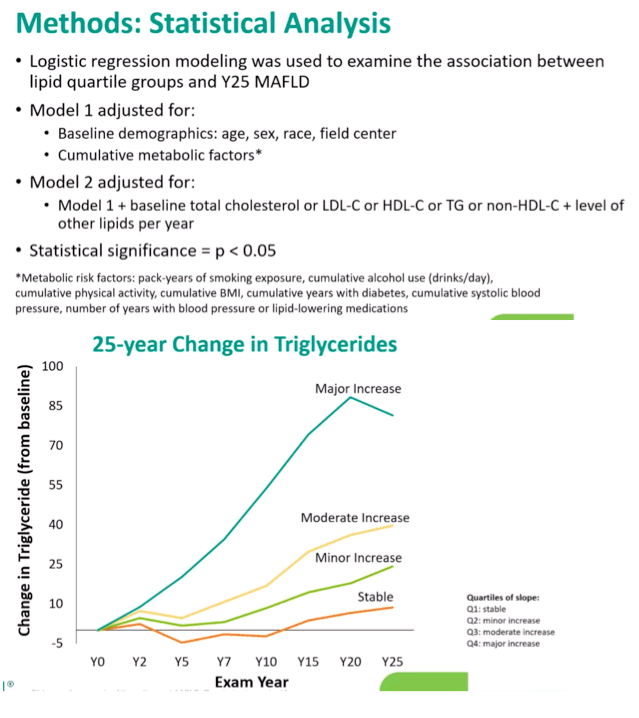
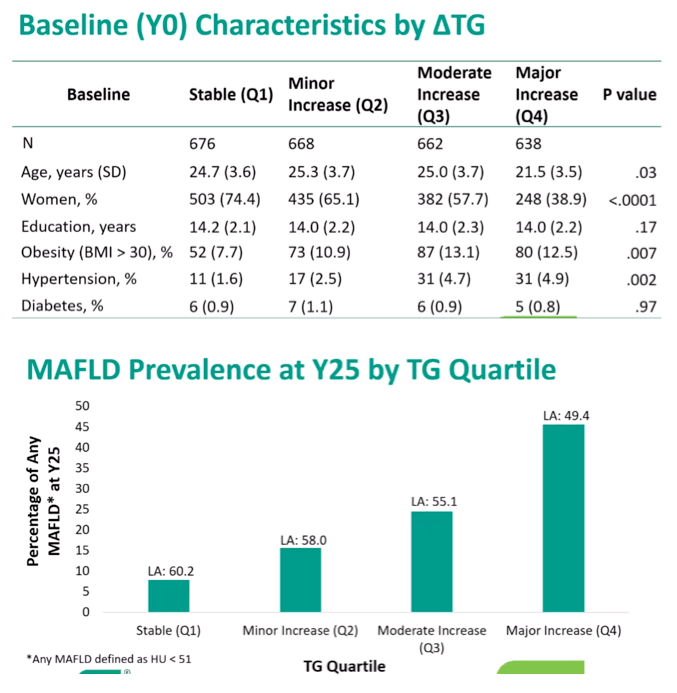
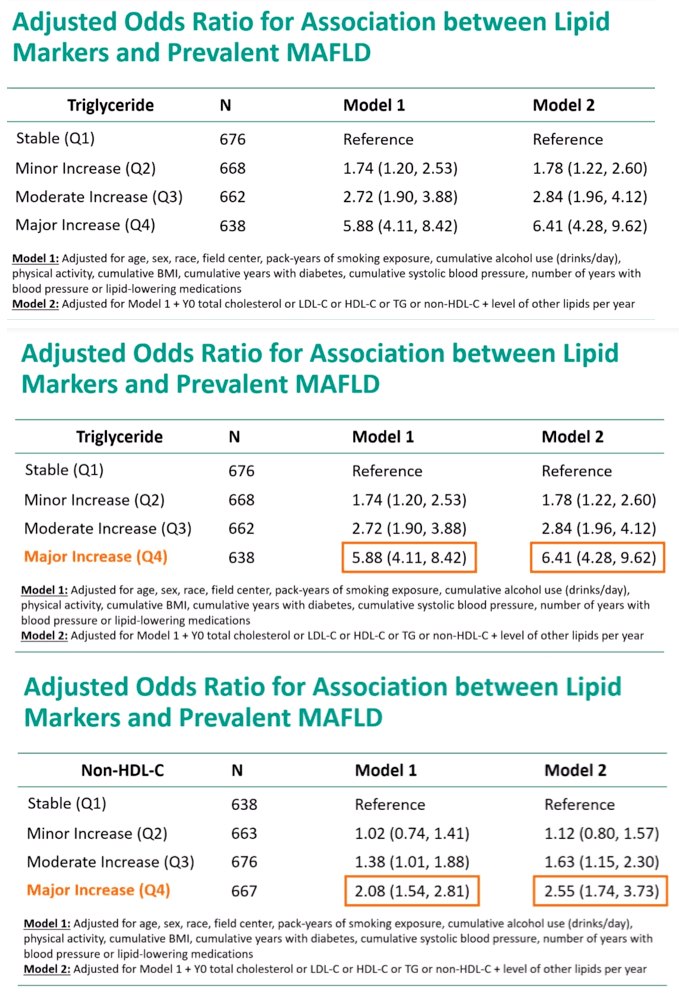
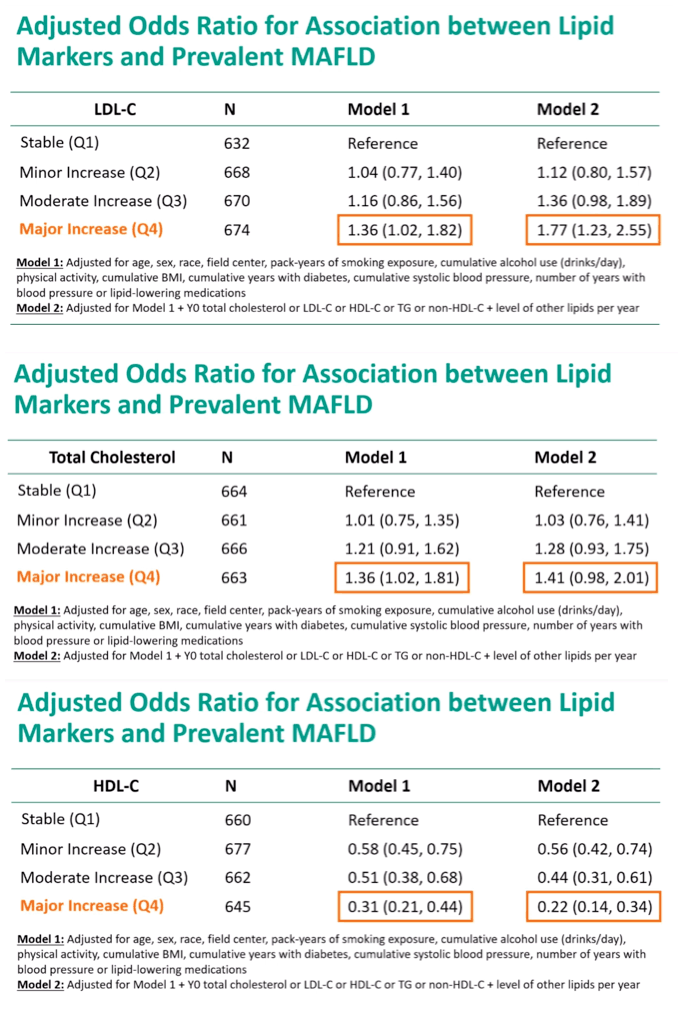
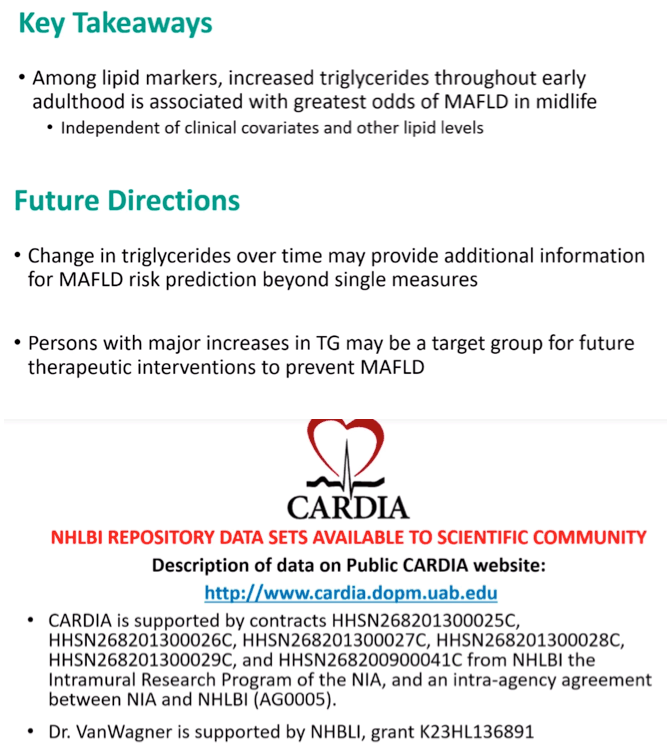
|
| |
|
 |
 |
|
|